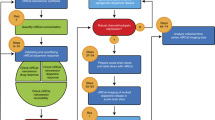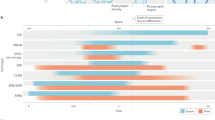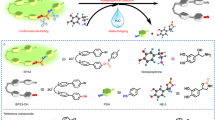Abstract
The development of molecular probes that allow in vivo imaging of neural signaling processes with high temporal and spatial resolution remains challenging. Here we applied directed evolution techniques to create magnetic resonance imaging (MRI) contrast agents sensitive to the neurotransmitter dopamine. The sensors were derived from the heme domain of the bacterial cytochrome P450-BM3 (BM3h). Ligand binding to a site near BM3h's paramagnetic heme iron led to a drop in MRI signal enhancement and a shift in optical absorbance. Using an absorbance-based screen, we evolved the specificity of BM3h away from its natural ligand and toward dopamine, producing sensors with dissociation constants for dopamine of 3.3–8.9 μM. These molecules were used to image depolarization-triggered neurotransmitter release from PC12 cells and in the brains of live animals. Our results demonstrate the feasibility of molecular-level functional MRI using neural activity–dependent sensors, and our protein engineering approach can be generalized to create probes for other targets.
This is a preview of subscription content, access via your institution
Access options
Subscribe to this journal
Receive 12 print issues and online access
$209.00 per year
only $17.42 per issue
Buy this article
- Purchase on Springer Link
- Instant access to full article PDF
Prices may be subject to local taxes which are calculated during checkout





Similar content being viewed by others
References
Buxton, R.B . Introduction to Functional Magnetic Resonance Imaging: Principles and Techniques (Cambridge University Press, New York, 2001).
Ogawa, S., Lee, T.M., Kay, A.R. & Tank, D.W. Brain magnetic resonance imaging with contrast dependent on blood oxygenation. Proc. Natl. Acad. Sci. USA 87, 9868–9872 (1990).
Logothetis, N.K. What we can do and what we cannot do with fMRI. Nature 453, 869–878 (2008).
Jasanoff, A. MRI contrast agents for functional molecular imaging of brain activity. Curr. Opin. Neurobiol. 17, 593–600 (2007).
Bloom, J.D. et al. Evolving strategies for enzyme engineering. Curr. Opin. Struct. Biol. 15, 447–452 (2005).
Li, Q.S., Schwaneberg, U., Fischer, P. & Schmid, R.D. Directed evolution of the fatty-acid hydroxylase P450 BM-3 into an indole-hydroxylating catalyst. Chemistry (Easton) 6, 1531–1536 (2000).
Glieder, A., Farinas, E.T. & Arnold, F.H. Laboratory evolution of a soluble, self-sufficient, highly active alkane hydroxylase. Nat. Biotechnol. 20, 1135–1139 (2002).
Meinhold, P., Peters, M.W., Chen, M.M., Takahashi, K. & Arnold, F.H. Direct conversion of ethane to ethanol by engineered cytochrome P450 BM3. ChemBioChem 6, 1765–1768 (2005).
Otey, C.R., Bandara, G., Lalonde, J., Takahashi, K. & Arnold, F.H. Preparation of human metabolites of propranolol using laboratory-evolved bacterial cytochromes P450. Biotechnol. Bioeng. 93, 494–499 (2006).
Knutson, B. & Gibbs, S.E. Linking nucleus accumbens dopamine and blood oxygenation. Psychopharmacology (Berl.) 191, 813–822 (2007).
Schultz, W. Multiple dopamine functions at different time courses. Annu. Rev. Neurosci. 30, 259–288 (2007).
Hyman, S.E., Malenka, R.C. & Nestler, E.J. Neural mechanisms of addiction: the role of reward-related learning and memory. Annu. Rev. Neurosci. 29, 565–598 (2006).
Damier, P., Hirsch, E.C., Agid, Y. & Graybiel, A.M. The substantia nigra of the human brain. II. Patterns of loss of dopamine-containing neurons in Parkinson's disease. Brain 122, 1437–1448 (1999).
Young, A.M., Joseph, M.H. & Gray, J.A. Increased dopamine release in vivo in nucleus accumbens and caudate nucleus of the rat during drinking: a microdialysis study. Neuroscience 48, 871–876 (1992).
Garris, P.A. & Wightman, R.M. Different kinetics govern dopaminergic transmission in the amygdala, prefrontal cortex, and striatum: an in vivo voltammetric study. J. Neurosci. 14, 442–450 (1994).
Gubernator, N.G. et al. Fluorescent false neurotransmitters visualize dopamine release from individual presynaptic terminals. Science 324, 1441–1444 (2009).
Lindsey, K.P. & Gatley, S.J. Applications of clinical dopamine imaging. Neuroimaging Clin. N. Am. 16, 553–573 (2006).
Ewing, A.G., Bigelow, J.C. & Wightman, R.M. Direct in vivo monitoring of dopamine released from two striatal compartments in the rat. Science 221, 169–171 (1983).
Michael, A.C., Ikeda, M. & Justice, J.B. Jr. Mechanisms contributing to the recovery of striatal releasable dopamine following MFB stimulation. Brain Res. 421, 325–335 (1987).
Duong, T.Q., Kim, D.S., Ugurbil, K. & Kim, S.G. Spatiotemporal dynamics of the BOLD fMRI signals: toward mapping submillimeter cortical columns using the early negative response. Magn. Reson. Med. 44, 231–242 (2000).
Munro, A.W. et al. P450 BM3: the very model of a modern flavocytochrome. Trends Biochem. Sci. 27, 250–257 (2002).
Macdonald, I.D., Munro, A.W. & Smith, W.E. Fatty acid-induced alteration of the porphyrin macrocycle of cytochrome P450 BM3. Biophys. J. 74, 3241–3249 (1998).
Ravichandran, K.G., Boddupalli, S.S., Hasermann, C.A., Peterson, J.A. & Deisenhofer, J. Crystal structure of hemoprotein domain of P450BM-3, a prototype for microsomal P450′s. Science 261, 731–736 (1993).
Modi, S. et al. NMR studies of substrate binding to cytochrome P450 BM3: comparisons to cytochrome P450 cam. Biochemistry 34, 8982–8988 (1995).
Lewis, D.F.V. . Guide to Cytochrome P450 Structure and Function (Taylor & Francis, New York, 2001).
Fasan, R., Chen, M.M., Crook, N.C. & Arnold, F.H. Engineered alkane-hydroxylating cytochrome P450(BM3) exhibiting nativelike catalytic properties. Angew. Chem. Int. Edn Engl. 46, 8414–8418 (2007).
Bloom, J.D., Labthavikul, S.T., Otey, C.R. & Arnold, F.H. Protein stability promotes evolvability. Proc. Natl. Acad. Sci. USA 103, 5869–5874 (2006).
Ohnuma, K., Hayashi, Y., Furue, M., Kaneko, K. & Asashima, M. Serum-free culture conditions for serial subculture of undifferentiated PC12 cells. J. Neurosci. Methods 151, 250–261 (2006).
Ewing, A.G., Wightman, R.M. & Dayton, M.A. In vivo voltammetry with electrodes that discriminate between dopamine and ascorbate. Brain Res. 249, 361–370 (1982).
Gerhardt, G.A., Rose, G.M. & Hoffer, B.J. Release of monoamines from striatum of rat and mouse evoked by local application of potassium: evaluation of a new in vivo electrochemical technique. J. Neurochem. 46, 842–850 (1986).
Chen, Z.J. et al. A realistic brain tissue phantom for intraparenchymal infusion studies. J. Neurosurg. 101, 314–322 (2004).
Michael, A.C., Ikeda, M. & Justice, J.B. Jr. Dynamics of the recovery of releasable dopamine following electrical stimulation of the medial forebrain bundle. Neurosci. Lett. 76, 81–86 (1987).
Vykhodtseva, N., McDannold, N. & Hynynen, K. Progress and problems in the application of focused ultrasound for blood-brain barrier disruption. Ultrasonics 48, 279–296 (2008).
Li, H. & Poulos, T.L. The structure of the cytochrome p450BM-3 haem domain complexed with the fatty acid substrate, palmitoleic acid. Nat. Struct. Biol. 4, 140–146 (1997).
Barnes, H.J., Arlotto, M.P. & Waterman, M.R. Expression and enzymatic activity of recombinant cytochrome P450 17 alpha-hydroxylase in Escherichia coli. Proc. Natl. Acad. Sci. USA 88, 5597–5601 (1991).
Omura, T. & Sato, R. The carbon monoxide-binding pigment of liver microsomes. I. Evidence for its hemoprotein nature. J. Biol. Chem. 239, 2370–2378 (1964).
Acknowledgements
We thank V. Lelyveld for helpful discussions and assistance with in vitro measurements, N. Shah for help with MRI procedures and W. Schulze for help with automated analysis methods. We are grateful to C. Jennings and D. Cory for comments and suggestions about the manuscript, and to D. Vaughan for consultation regarding histology. We thank P. Caravan and again D. Cory for access to low-field relaxometers. M.G.S. thanks the Fannie and John Hertz Foundation and the Paul and Daisy Soros Fellowship for generous support. This work was funded by a Dana Foundation Brain & Immuno-Imaging grant, a Raymond & Beverley Sackler Fellowship and US National Institutes of Health (NIH) grants R01-DA28299 and DP2-OD2441 (New Innovator Award) to A.J., NIH grant R01-GM068664 and a grant from the Caltech Jacobs Institute for Molecular Medicine to F.H.A. and NIH grant R01-DE013023 to R.L.
Author information
Authors and Affiliations
Contributions
M.G.S. conceived and performed the directed evolution and in vitro assessment of dopamine sensors; G.G.W. designed and conducted the in vivo experiments; P.A.R. performed directed evolution screening for BM3h variants; J.O.S. assisted with screening and in vitro experiments; B.K. assisted with data analysis for in vivo experiments; A.S. assisted with in vivo experiments; C.R.O. worked with M.G.S. to establish BM3h screening methods; R.L. provided consultation and essential materials; F.H.A. supervised the directed evolution work; A.J. established research direction, supervised the project overall and co-wrote the paper with M.G.S. and G.G.W.
Corresponding author
Ethics declarations
Competing interests
The authors declare no competing financial interests.
Supplementary information
Supplementary Text and Figures
Supplementary Figs. 1–6 and Supplementary Results (PDF 1540 kb)
Rights and permissions
About this article
Cite this article
Shapiro, M., Westmeyer, G., Romero, P. et al. Directed evolution of a magnetic resonance imaging contrast agent for noninvasive imaging of dopamine. Nat Biotechnol 28, 264–270 (2010). https://doi.org/10.1038/nbt.1609
Received:
Accepted:
Published:
Issue Date:
DOI: https://doi.org/10.1038/nbt.1609
This article is cited by
-
Engineered serum markers for non-invasive monitoring of gene expression in the brain
Nature Biotechnology (2024)
-
Wireless agents for brain recording and stimulation modalities
Bioelectronic Medicine (2023)
-
A brief review of non-invasive brain imaging technologies and the near-infrared optical bioimaging
Applied Microscopy (2021)
-
Genetically encodable materials for non-invasive biological imaging
Nature Materials (2021)
-
Perylene diimide/MXene-modified graphitic pencil electrode-based electrochemical sensor for dopamine detection
Microchimica Acta (2021)



